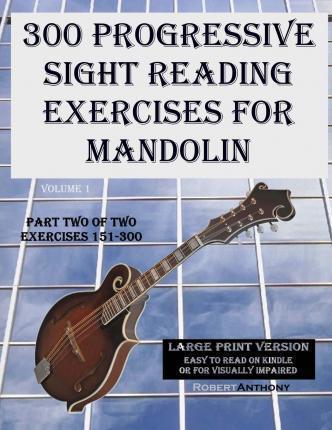THIS IS THE LARGE PRINT VERSION OF THIS BOOK: It was designed to be easy to SEE on a Kindle or for the vision impaired. The print is VERY LARGE on purpose. For the Large Print Version, the 300 exercises are broken down into two books. Part One contains exercises 1-150 and Part Two contains exercises 151-300. THIS IS NOT A METHOD BOOK. It is precisely what it says it is: 300 Progressive Sight Reading Exercises! Volume One is comprised of 300 progressive eight-bar exercises that cover the keys of C Major, F Major, G Major, A Minor, D Minor and E Minor. Time signatures include 4/4 (Common Time), 3/4, 2/4, 6/8, and 2/2 (Cut Time). The remaining key signatures, additional time signatures, tempo markings and dynamics markings will be covered in future volumes. All of the exercises are eight measures long. Many sonatinas, jazz standards, and pop songs use "32 Bar Form" (A A B A), "Binary Form" (A B), and "Ternary Form" (A B A), with each section often being eight bars. Thus, eight measures (one 'period' of music) makes the perfect length for sight-reading studies in my opinion. How to use this book: Start where the exercises begin and work across the book - from exercise 1, 5, 9, 13 and so on until you get to a point where the music challenges you and then mark your ending point. The next practice, play exercises 2, 6, 10, 14, and so on... The next: 3, 7, 11, 15 and so on, and finally 4, 8, 12, 16, and so on. If you want to work at your "break point" (the point in the book where you can no longer play musically), work DOWN the page instead of across the pages. "These books differ from conventional 'methods' in that technical and theoretical instructions have been omitted, in the belief that these are more appropriately left for the teacher to explain to the student." - Bela Bartok, Mikrokosmos. I whole-heartedly agree with Bartok's sentiment and if music teachers would ask their students what they like least (or hate the most) about typical lessons, it is the method books that win this contest EVERY TIME. I have completely eliminated method books from my own teaching practice and have much happier and more productive students than ever. While this book is intended to train sight-reading skills, it may also be used by beginners or those new to reading to acquire basic reading skills, but it assumes one either has a teacher or can at least find C on their instrument. It starts at a very basic level (only three notes) and adds a new note, rhythm, or concept every fo













